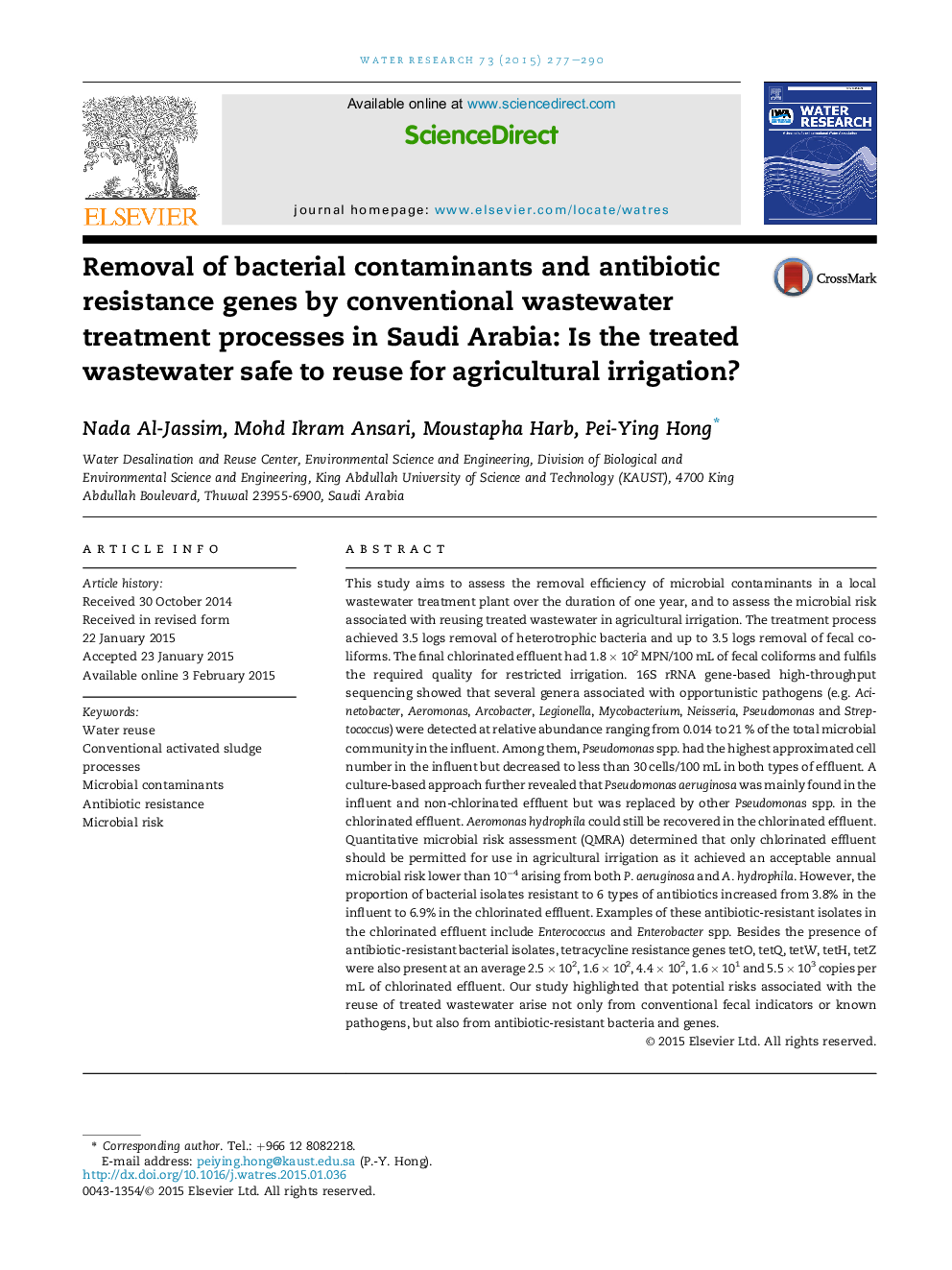| کد مقاله | کد نشریه | سال انتشار | مقاله انگلیسی | نسخه تمام متن |
|---|---|---|---|---|
| 4481246 | 1623095 | 2015 | 14 صفحه PDF | دانلود رایگان |
• Local wastewater treatment process achieves 3.53 logs removal of heterotrophic bacteria.
• 3.47 logs removal of fecal coliforms was also achieved.
• No Pseudomonas aeruginosa were present in chlorinated effluent but Aeromonas hydrophila was.
• Tetracycline resistance genes and antibiotic-resistant bacteria remain too.
• QMRA denoted that chlorinated effluent should be permitted for use in agricultural irrigation.
This study aims to assess the removal efficiency of microbial contaminants in a local wastewater treatment plant over the duration of one year, and to assess the microbial risk associated with reusing treated wastewater in agricultural irrigation. The treatment process achieved 3.5 logs removal of heterotrophic bacteria and up to 3.5 logs removal of fecal coliforms. The final chlorinated effluent had 1.8 × 102 MPN/100 mL of fecal coliforms and fulfils the required quality for restricted irrigation. 16S rRNA gene-based high-throughput sequencing showed that several genera associated with opportunistic pathogens (e.g. Acinetobacter, Aeromonas, Arcobacter, Legionella, Mycobacterium, Neisseria, Pseudomonas and Streptococcus) were detected at relative abundance ranging from 0.014 to 21 % of the total microbial community in the influent. Among them, Pseudomonas spp. had the highest approximated cell number in the influent but decreased to less than 30 cells/100 mL in both types of effluent. A culture-based approach further revealed that Pseudomonas aeruginosa was mainly found in the influent and non-chlorinated effluent but was replaced by other Pseudomonas spp. in the chlorinated effluent. Aeromonas hydrophila could still be recovered in the chlorinated effluent. Quantitative microbial risk assessment (QMRA) determined that only chlorinated effluent should be permitted for use in agricultural irrigation as it achieved an acceptable annual microbial risk lower than 10−4 arising from both P. aeruginosa and A. hydrophila. However, the proportion of bacterial isolates resistant to 6 types of antibiotics increased from 3.8% in the influent to 6.9% in the chlorinated effluent. Examples of these antibiotic-resistant isolates in the chlorinated effluent include Enterococcus and Enterobacter spp. Besides the presence of antibiotic-resistant bacterial isolates, tetracycline resistance genes tetO, tetQ, tetW, tetH, tetZ were also present at an average 2.5 × 102, 1.6 × 102, 4.4 × 102, 1.6 × 101 and 5.5 × 103 copies per mL of chlorinated effluent. Our study highlighted that potential risks associated with the reuse of treated wastewater arise not only from conventional fecal indicators or known pathogens, but also from antibiotic-resistant bacteria and genes.
Figure optionsDownload high-quality image (220 K)Download as PowerPoint slide
Journal: Water Research - Volume 73, 15 April 2015, Pages 277–290
